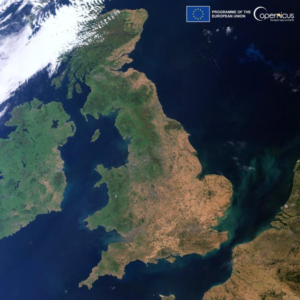Scientists have revealed the scale of the drought affecting the UK using images captured from space, as hosepipe bans have been announced for several parts of the country.
Earth Observation (EO) experts from the University of Leicester used the data captured to show the correlation between high land surface temperatures and drought-affected areas.
They mapped land surface temperatures during the heatwave using measurements from the European Space Agency’s (ESA) Sentinel-3 satellites 800km high in space.
Their latest map, showing temperatures at approximately midday on Thursday 11 August, shows that areas with higher land temperatures suffer more from drought conditions.

An Agency spokesperson said: ‘We don’t use a single definition for drought so whilst it’s caused by a period of low rainfall, the nature, timing and impacts on people, the environment, agriculture or business will vary.
‘Some droughts are short and intense like a hot, dry summer, while others are long and take time to develop over multiple seasons.’
Parts of the country currently suffering from drought include Devon and Cornwall; Solent and South Downs; Kent and south London; Hertfordshire and north London; East Anglia; Thames; Lincolnshire and Northamptonshire and the East Midlands.
The scientists from the National Centre for Earth Observation (NCEO) found the highest land temperatures reached around 47.8°C in Lakenheath, Suffolk, and parts of London. Other areas affected by drought and urban areas experienced temperatures between 42 and 46°C.
Land surface temperature is a separate measure to ambient air temperature, but the two are linked, as warmth rising from the earth is affecting weather and climate patterns.

Urban areas are particularly prone to higher land surface temperatures due to a concentration of concrete, buildings, and other dense materials, or ‘heat islands’, absorbing heat at a higher rate than natural land.
Dr Darren Ghent, NCEO Leader and Research Fellow for Land Surface Temperature, said: ‘Space-based observations of the temperature of the surface of the land offer unparalleled knowledge of the spatial structure of these heatwave events.
‘The image of the UK from Thursday shows land temperatures as high as 47.8°C, in Lakenheath, Suffolk, and it’s plain to see that where land temperatures are highest, those areas are most affected by drought.’
Photos by Matt Palmer and the University of Leicester












